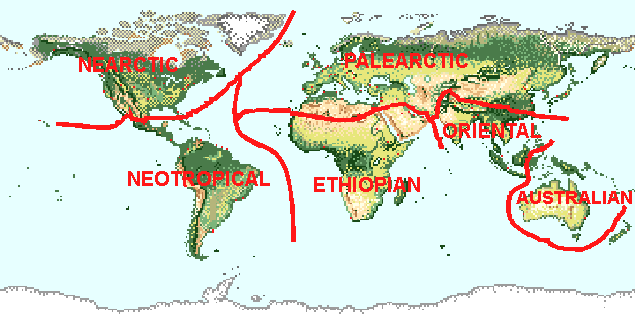ZOOGEOGRAPHICAL DISTRIBUTION
Animal geography or Zoogeography is a part of zoology which concerned with distribution of animal over the whole world.There are nearly 8.7 million species (http://www.bbc.co.uk/news/science-environment-14616161) of animal, which is impossible to cover up and study the distribution of each species. Commonly zoogeography of land and freshwater aquatic animals are taken into account(2% of the all animals!).
Distribution of animals can be studied at 3 levels:
1. Geographical distribution: Over the whole world.
2. Regional distribution: In selected segments of the worlds.
3. Local distribution: In a certain locality.
The distribution of animal and plant called fauna and flora respectively.
When distribution of animal is represented on world map, such a map is called Animal map or Distribution map. The map which is plotted depicting the distribution of particular group called simple maps and the map which is plotted depicting the distribution of all animal, called compound map.
The distributions of animals may be continuous(rat,cat, cuckoo) and discontinuous(Lungfish, coral, giraffe).
 |
| Lung fish |
 |
| Giraffe |
There can be 2 possible way to study the geographical distribution of the animal in the world:
1. Distribution of individual species over the world.
2. To divide the world into faunal region and to describe their regional vertebrate fauna and their inter-relationship.
The first attempt to divide the world into zoogeographical region was made in 1857 by P.L. Sclater, the secretary of Zoological Society of London. His division was based upon the different kinds of birds found in different regions. Nineteen years later in 1876, A. R. Wallance supported Scalter's zoogeographical regions:
1. Palaeartic Region: Europe, North Africa, The part of Asia north to the Himalaya.
2. Neartic Region: It includes North America, Greenland and Iceland
 3. Neotropical Region: It includes whole of South America and most of Central America.
3. Neotropical Region: It includes whole of South America and most of Central America.
5. Oriental(Indian) Region: It includes southern Asia from Baluchistan to Myanmar,South-east Asia and some of the islands of the Indonesian region.
6. Australian Region: It includes Australia, Tasmania, New Zealand, New Guinea and Eastern islands of Indonesia.
In 1887, Heilprin suggested that Palaeartic and Neartic region has many features in common, thus he combined this 2 regions as Holarctic region.
H. Robinson give a recent and most accepted classification, it will discussed here:
I. Arctogea click on Arctogea for Details
(a) Holarctic click on Holoarctic for Details
1.Palaearctic click on Palaearctic for Details
2. Nearctic click on Nearctic for Details
(b) Ethiopian
(c) Oriental
II. Neogea(Neotropical)
III. Notogea(Australia)
Here I am going to discuss a common scheme of zoogeographical distribution:
For more click here
1. Palaeartic Region: Europe, North Africa, The part of Asia north to the Himalaya.
2. Neartic Region: It includes North America, Greenland and Iceland
 3. Neotropical Region: It includes whole of South America and most of Central America.
3. Neotropical Region: It includes whole of South America and most of Central America.5. Oriental(Indian) Region: It includes southern Asia from Baluchistan to Myanmar,South-east Asia and some of the islands of the Indonesian region.
6. Australian Region: It includes Australia, Tasmania, New Zealand, New Guinea and Eastern islands of Indonesia.
In 1887, Heilprin suggested that Palaeartic and Neartic region has many features in common, thus he combined this 2 regions as Holarctic region.
H. Robinson give a recent and most accepted classification, it will discussed here:
I. Arctogea click on Arctogea for Details
(a) Holarctic click on Holoarctic for Details
1.Palaearctic click on Palaearctic for Details
2. Nearctic click on Nearctic for Details
(b) Ethiopian
(c) Oriental
II. Neogea(Neotropical)
III. Notogea(Australia)
Here I am going to discuss a common scheme of zoogeographical distribution:
For more click here
*** This blog is incomplete, and developing is undergoing.



Nice document about zoogeography.
ReplyDelete